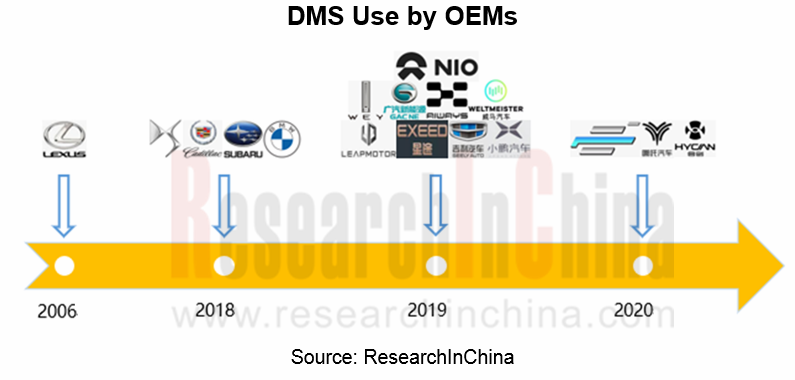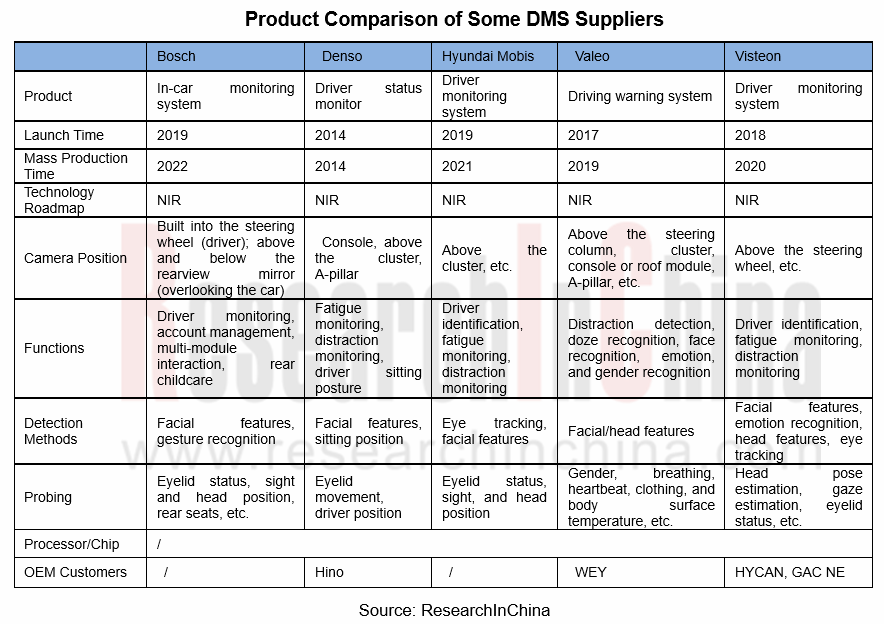Automotive DMS (Driver Monitoring System) Research Report, 2019-2020
Automotive DMS Research: DMS installations shoot up, with a year-on-year upsurge of 360% in Q1 2020
DMS (Driver Monitoring System) is bifurcated into active DMS and passive DMS. Passive DMS judges the driver's state based on the steering wheel turning and driving trajectory. Active DMS, generally enabled by cameras and near-infrared technology, detects the driver's state from eyelid closure, blinking, gaze direction, yawning, and head movements. Only active DMS is studied in this report.
In 2006, the Lexus LS 460 was packed with active DMS for the first time, and the camera was mounted on the top of the steering column cover with six built-in near-infrared LEDs. Automakers are not interested in active DMS, because they believe that it increases the cost of the vehicle and consumers may be reluctant to pay for it. Yet, a train of accidents over the recent years highlight the importance of DMS in ADAS, especially L2/L3. Active DMS started to soar from 2018, with the massive availability of the L2 system and the to-be-spawned L3 system.
Euro-NCAP issued a roadmap for 2025, which requires that new cars must be equipped with DMS from July 2022. China has legislated the mandatory installation of DMS for commercial vehicles, and similar stipulations for passenger cars are just around the corner. The active DMS market is growing prosperous as relevant chip, software and algorithm vendors are vigorously promoting the development of DMS technology.

10,170 units of active DMS were installed in new passenger cars in China in 2019, surging by 174% on an annualized basis. In 2020Q1, the installations skyrocketed 360% year-on-year to 5,137 units amid the wide use of active DMS in the models priced between RMB150,000 and RMB200,000 and the adoption by WEY, Xpeng, Geely, to name a few.
Most Tier1 suppliers have launched total DMS solutions, including Valeo, Bosch, Continental, Denso, Hyundai Mobis, Visteon, Veoneer, etc. Among Chinese companies, the DMS of Hikvision, SenseTime, Baidu, and Dahua Technology have been found on various brand models.

Rise of DMS algorithm developers
DMS is used mainly to monitor drivers’ fatigue and distraction. Yet a larger number of sensors, vision + infrared cameras, and even radars mean availability of more functions, e.g., face recognition, age and gender recognition, emotion recognition, seat belt detection, posture, position and forgetting detection, cabin abnormality detection, and infant detection. Face, gender and expression recognition helps with identity authentication and offers richer interaction between human and vehicle. DMS that is now used just for early warning will enable personalized body control and more functions once it is coupled with ADAS/AD systems.
In Valeo’s case, its AI-driven DMS uses convolutional neural network (CNN) algorithms for emotion recognition and allows unique settings by recognizing the driver’s face.
The versatility, however, cannot be met only by Tier1 suppliers in the short run. That’s why DMS is often co-developed by Tier1 suppliers and algorithm companies.
With years of efforts on development of computer vision technology, ArcSoft Corporation Limited has developed DMS, ADAS and BSD, among others, to meet automobile industry’s needs for vision-related capabilities. The developer’s intelligent driving algorithm business expanded rapidly in 2019, contributing revenue of RMB16.0566 million, a substantial increase as compared to 2018 (RMB2.2021 million), and rang in RMB17.0076 million in the first quarter of 2020, more than the full-year revenue of 2019.
ArcSoft’s peers such as EyeSight, Smart Eye, FotoNation and Seeing Machine all have been working on development of software algorithms for years. Even so, use of DMS technology still faces plenty of tough challenges:
- The highest technical barrier before application of vision-based DMS technology is its performance in high or low light which may lead to all white or all black images, respectively. In this case, even the most advanced algorithms won’t work.
- How to quantitatively define fatigue and drowsiness also creates a bottleneck to use of DMS. The most effective way to measure fatigue and define the relation between fatigue and temperature, dermal resistance, eye movement, respiratory rate, heart rate and brain activity, is measurement of pulse and heart rate variability (HRV), but the technology is still not mature enough.
- Widely varying signal-to-noise ratio and contrast, obscured and dithered images, and light difference in different weathers and time periods will issue in images of differing brightness.
- Face detection challenges: in-plane rotation of face; out-of-plane rotation of face; existence of cosmetics, beard and glasses; expression (happy, cry, etc.); obscured face; real-time processing requirements.
- DMS latency caused by insufficient computing power, communication, etc..
Interference to users caused by too many false alarms.
- Few sample databases for training algorithms.
Companies are trying to add more sensors and more powerful chips to solve the problems that vision cameras fail to address in multiple scenarios.
Hardware improvement and cockpit monitoring
In May 2019, OmniVision Technologies and Shanghai Fullhan Microelectronics announced a joint solution for capturing and processing high quality color (RGB) and infrared (IR) automotive interior images, day and night, with a single camera. This solution combines OmniVision’s OV2778 2MP RGB-IR image sensor which offers high sensitivity across all lighting conditions with Fullhan’s FH8310 image signal processor (ISP). The result is high quality video for both machine vision in-cabin monitoring systems (IMS) and viewing applications, simultaneously, providing integrated solutions for facial recognition, the detection of objects and unattended children, remote monitoring, and recording for ride-hailing and robotaxi vehicles.
In June 2019, Vayyar, an Israeli startup, announced the launch of the first automotive 4D point cloud application on a single radar chip. The single chip with point cloud displays the dimension, shape, location and movement of people and objects, enabling the complete classification of the car’s environment, regardless of bad lighting or harsh weather conditions. In-cabin solutions include seat belt reminders, optimized airbag deployment, gesture control, driver drowsiness alerts, and infant detection alarms.
In September 2019, ON Semiconductor rolled out a complete in-cabin monitoring system inclusive of driver monitoring and occupant monitoring functions. The demonstration includes three ON Semiconductor 2.3-megapixel RGB-IR image sensors. This multi-camera system utilizes Ambarella’s CV2AQ System-on-Chip (SoC) and integrates Eyeris’ AI software performing complex body and facial analytics, occupant activity monitoring, object detection, among others.
In February 2020, Analog Devices, Inc. (ADI) announced a collaboration with Jungo to develop a Time-of-Flight (ToF) and 2D infrared- (IR) based camera solution to enable driver- and in-cabin monitoring in vehicles. The combination of ADI’s ToF technology with Jungo’s Codriver software is expected to enable the monitoring of vehicle occupants for levels of drowsiness and distraction by observing head and body position as well as eye gaze.
Valeo has also rolled out its cockpit monitoring technologies, such as vision-based rear seat monitoring solution and radar-based living beings detection solution.
EyeSight Cabin Sense in-car Occupancy Monitoring System (OMS) detects occupants, their posture or whether they wear seatbelts or not, as well as whether any child or object like a bag is forgotten in car or not.
In a nutshell, DMS will be thriving with wide use of L2/L3 automated driving in the upcoming several years. In future, it will evolve into cockpit monitoring system which will play a crucial role even in the era of L4 autonomy.
Two-wheeler Intelligence and Industry Chain Research Report, 2025-2026
Two-Wheeler Electric Vehicle Research: New National Standard Drives Intelligent Popularization, AI Agent Makes Its Way onto Vehicles
ResearchInChina releases the "Two-wheeler Intelligence and Industr...
China Smart Door and Electric Tailgate Market Research Report, 2025
Smart Door Research: Driven by Automatic Doors, Knock-Knock Door Opening, etc., the Market Will Be Worth Over RMB100 Billion in 2030.
This report analyzes and researches the installation, market size...
New Energy Vehicle Thermal Management System Industry Research Report, 2025-2026
Policy and Regulation Drive: Promoting the Development of Electric Vehicle Thermal Management Systems towards Environmental Compliance, Active Safety Protection, and Thermal Runaway Management
Accord...
Intelligent Vehicle Redundant Architecture Design and ADAS Redundancy Strategy Research Report, 2025-2026
Research on Redundant Systems: Septuple Redundancy Architecture Empowers High-Level Intelligent Driving, and New Products Such as Corner Modules and Collision Unlock Modules Will Be Equipped on Vehicl...
Passenger Car Mobile Phone Wireless Charging Research Report, 2025
Automotive Wireless Charging Research: Domestic Installation Rate Will Exceed 50%, and Overseas Demand Emerges as Second Growth Driver.
The Passenger Car Mobile Phone Wireless Charging Research Repor...
Automotive 4D Radar Industry Research Report 2025
4D radar research: From "optional" to "essential," 4D radar's share will exceed 50% by 2030.
1. 4D imaging radar has transformed from an "optional" to a "must-have" sensor.
4D radar adds the detecti...
China Automotive Multimodal Interaction Development Research Report, 2025
Research on Automotive Multimodal Interaction: The Interaction Evolution of L1~L4 Cockpits
ResearchInChina has released the "China Automotive Multimodal Interaction Development Research Report, 2025"...
Automotive Vision Industry Report, 2025
Automotive Vision Research: Average Camera Installation per Vehicle Reaches 5.2 Units, and Front-View Tricam Installation Exceeds 1.2 Million Sets.
From January to September 2025, the total installa...
Automotive Infrared Night Vision System Research Report, 2025
Automotive night vision research: The rise of infrared AEB, with automotive infrared night vision experiencing a 384.7% year-on-year increase from January to September.
From January to September 2025...
New Energy Vehicle Cross-Domain (Electric Drive System and Powertrain Domain) Integration Trend Report 2025-2026
Electric Drive and Powertrain Domain Research: New technologies such as three-motor four-wheel drive, drive-brake integration, and corner modules are being rapidly installed in vehicles.
Electric dri...
Analysis on Desay SV and Joyson Electronic's Electrification, Connectivity, Intelligence and Sharing, 2025
Research on Desay SV and Joyson Electronic: Who is the No.1 Intelligent Supplier?
Both Desay SV and Joyson Electronic are leading domestic suppliers in automotive intelligence. "Analysis on Desay SV ...
OEMs and Tier 1 Suppliers' Cost Reduction and Efficiency Enhancement Strategy Analysis Report, 2025
ResearchInChina released the "OEMs and Tier 1 Suppliers' Cost Reduction and Efficiency Enhancement Strategy Analysis Report, 2025", summarizing hundreds of cost reduction strategies to provide referen...
Automotive Fixed Panoramic Sunroof and Smart Roof Research Report, 2025
With the intelligent application of car roofs as the core, this report systematically sorts out a series of new products such as fixed panoramic sunroof/openable sunroof, ceiling screen, roof ambient ...
Automotive-Grade Power Semiconductor and Module (SiC, GaN) Industry Research Report, 2025
SiC/GaN Research: Sales volume of 800V+ architecture-based vehicles will increase more than 10 times, and hybrid carbon (SiC+IGBT) power modules are rapidly being deployed in vehicles.
Sales volume o...
Cockpit Agent Engineering Research Report, 2025
Cockpit Agent Engineering Research: Breakthrough from Digital AI to Physical AI
Cockpit Agent Engineering Research Report, 2025 starts with the status quo of cockpit agents, summarizes the technical ...
Prospective Study on L3 Intelligent Driving Technology of OEMs and Tier 1 Suppliers, 2025
L3 Research: The Window of Opportunity Has Arrived - Eight Trends in L3 Layout of OEMs and Tier 1 Suppliers
Through in-depth research on 15 OEMs (including 8 Chinese and 7 foreign OEMs) and 9 Tier 1 ...
China Commercial Vehicle IoV and Intelligent Cockpit Industry Research Report 2025
Commercial Vehicle IoV and Cockpit Research: The Third Wave of Passenger Car/Commercial Vehicle Technology Integration Arrives, and T-Box Integrates e-Call and 15.6-inch for Vehicles
I. The third wav...
Intelligent Vehicle Electronic and Electrical Architecture (EEA) and Technology Supply Chain Construction Strategy Research Report, 2025
E/E Architecture Research: 24 OEMs Deploy Innovative Products from Platform Architectures to Technical Selling Points
According to statistics from ResearchInChina, 802,000 passenger cars with domain...